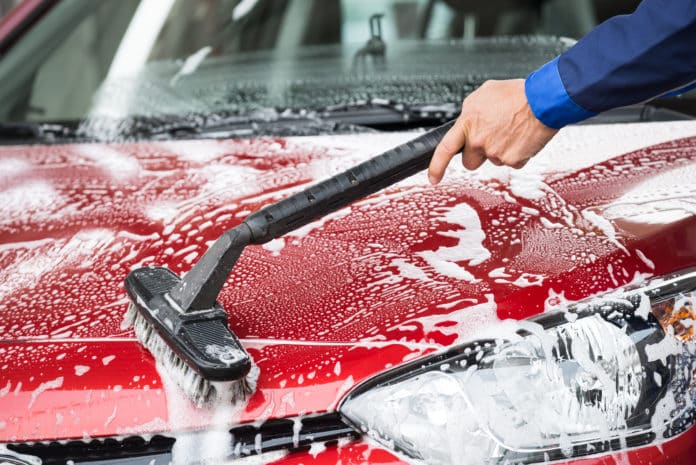Every year, the same problem – cold weather, ice, salted roads, and seemingly endless bottles of screen wash. Even the most detailed and thorough jet washing can’t rid all the nooks and crannies around your car’s bodywork of the built-up dirt and corrosive road salt spray, so as the clocks change and the first shoots of spring emerge, it’s a great time to plan for a thorough pampering – for your car.
Why wash your car?
Some people are happy to let the car remain grubby, but if you’re considering selling then a typical car valuation assumes a presentable, attractive vehicle. Around March, that’s especially important – showrooms are busy with buyers looking for new-registration deals, or the trade-ins those deals attract, so it’s a great time to sell your car.
But even if you aren’t considering selling, a good scrub is important for your car’s long-term prospects. With the ban on new combustion-engine sales looming, the existing stock of petrol and diesel cars will have to last a long time; it can if you keep on top of bodywork maintenance. It’s not just about making it look good; plenty of fresh water rinsing out the seals and inaccessible corners where spray and rain can get but a wash mitt can’t is really essential for preventing rust. It also provides a chance to check for stone chips and damage.
How to rid your car of winter grime, step-by-step.
Pick a dry, warm weekend if you can – direct sunlight is not desirable, but overall bright and not-windy days make it a nicer job for you. You’ll find a pressure washer makes the job a lot nicer, mains-powered ones are best for intensive cleaning but cordless models are surprisingly good – you can even get ones that pull water from a bucket if you don’t have an outside tap to hand.
Before you wash your car, have a look online for drain points that might need attention. On convertible cars, these can cause damp, smelly interiors, and a lot of extra work if you jetwash without them being cleared, but all cars have drainage channels that can get blocked with leaves and debris. A trombone cleaning brush is often the most useful (and cheap) tool to tackle these! Sunroof drains on factory-fitted tops need something narrower, and less likely to detach the channels deep in the bodywork and hard to get to – we recommend flexible wire.
Begin by rinsing the car off with clean water. Start at the top and work down, and use a gentle but constant flow around roof channels and trim edges. Too much-directed pressure can damage stuck-on items or get past seals, but a large volume of flowing water can dislodge stubborn moss and built-up dirt. Once the top is rinsed thoroughly, turn your attention to the wheel arches, wheels and suspension components (another reason to rinse that salt off – rusted suspension and brakes can fail, plus it’s horrible to work on when something does go wrong). Get in behind-the-wheel arches and dislodge all that mud, but be careful not to get your hand in the path of a jet wash spray as it can break the skin.
Get your cleaning products ready!
Take two bottles into the carport? If you thought you could just wash, and go, think again – you’ll want to take time over the first post-winter wash. Snowfoams are ideal starters, clinging to muck and softening dirt to make it rinse off easily after a five-minute wait. Good ones include lots of soap to make sure you don’t end up scratching the paint with small bits of grit. Apply snow foam from the bottom up, leaving it the longest time to work on the grime.
Rinse the snow foam off and you can get your wash mitt and bucket of shampoo ready. We’re back to the top-down approach, and if you want to be serious about it you’ll have two buckets – apply soap from a warm bucket of clean water and rinse the mitt in a separate bucket; a grit trap in the bottom of the bucket is even better.
Don’t apply too much pressure, just let the shampoo work to dislodge dirt and soften dried bird lime or sap.
Once you’ve cleaned the bodywork, rinse, and dry with a chamois, microfibre towel, or if you’re fancy, a car blow-dryer. Yes, they exist.
Time to shine – wax and detailing
If you want to feel great about your car or want buyers to, waxing it is a surefire way to get a gleaming finish. You can go for traditional waxes and they’ll hold up for a wash or two, but for a seriously grubby car, you will want to start by getting the paint smooth. A clay bar is perfect for this, lifting muck out of the top layer. Once clayed, you can use resin, ceramic or traditional waxes. Ceramic sealers maintain the shine for the longest period but require more care. Make sure every seal and trim piece is dry as there’s nothing more annoying than your polishing cloth finding some forgotten water and smearing it across a freshly-waxed panel.
You may also want to clean your alloy wheels and polish plastic headlights around this time. Do the latter before waxing the car, as the process can be messy.
Once cleaned your car will look years younger, and you’ll have a better idea of how it’s fared through winter. And you’ll have burned a few calories too. Time for a cuppa and a sit down – just about the point where you realise the interior still needs cleaning…


